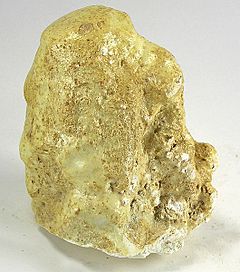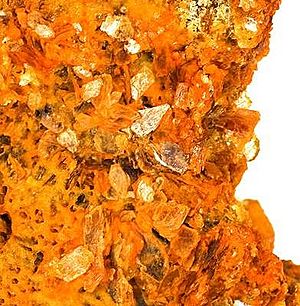Copiapite facts for kids
Quick facts for kids Copiapite |
|
|---|---|

Copiapite from the Bolesław Mine, Kłodzko District, Lower Silesia, Poland
|
|
| General | |
| Category | Sulfate minerals |
| Formula (repeating unit) |
Fe2+Fe3+4(SO4)6(OH)2·20(H2O) |
| Strunz classification | 7.DB.35 |
| Crystal symmetry | P1 |
| Unit cell | a = 7.337 Å, b = 18.76 Å, c = 7.379 Å; α = 91.47°, β = 102.18°, γ = 98.95°; Z = 1 |
| Identification | |
| Color | Sulfur-yellow to orange when crystalline, greenish-yellow to olive-green when massive |
| Crystal habit | Tabular pseudo-orthorhombic platy crystals, typically in scaly incrustations or granular pulverulent aggregates |
| Crystal system | Triclinic |
| Twinning | Contact twins |
| Cleavage | Perfect on {010}, imperfect on {101} |
| Fracture | Irregular/uneven, micaceous |
| Tenacity | Fragile |
| Mohs scale hardness | 2.5 - 3 |
| Luster | Pearly on {010} |
| Diaphaneity | Transparent to translucent |
| Specific gravity | 2.04–2.17 |
| Optical properties | Biaxial (+) |
| Refractive index | nα = 1.506 - 1.540 nβ = 1.528 - 1.549 nγ = 1.575 - 1.600 |
| Birefringence | δ = 0.069 |
| Pleochroism | X = Y = pale yellow to colorless; Z = sulfur-yellow |
| 2V angle | Measured: 45° to 74°, Calculated: 48° to 72° |
| Solubility | Soluble in water |
Copiapite is a fascinating mineral! It's a type of sulfate mineral that contains iron and water. Its chemical formula is Fe2+Fe3+4(SO4)6(OH)2·20(H2O). This means it has iron, sulfur, oxygen, and hydrogen in its makeup, plus a lot of water molecules. The name Copiapite can also refer to a group of similar minerals.
What is Copiapite?
Copiapite is a secondary mineral. This means it forms from other minerals that have changed over time. It usually appears when iron sulfide minerals, like pyrite (also known as "fool's gold"), break down. This breakdown happens due to weathering or oxidation, which is like rusting.
It can also form rarely near fumaroles. These are openings in the Earth's crust that release steam and gases. Copiapite is the most common mineral in its group.
How to Identify Copiapite
Copiapite rarely forms as single, perfect crystals. When it does, it belongs to the triclinic crystal system. This system means its crystals have a unique, often slanted shape.
- Color: It can be pale yellow to bright yellow. Sometimes it's orange or even greenish-yellow.
- Solubility: Copiapite dissolves in water. When it dissolves, it turns the water a deep orange or reddish-orange color.
- Acidity: When dissolved, copiapite makes the water very acidic. In some places, like the Richmond Mine in California, the water can become extremely acidic due to high concentrations of copiapite.
- Distinguishing Features:
- You can tell it apart from native sulfur because it doesn't smell when it dissolves in water. Sulfur has a distinct smell.
- It looks similar to some uranium minerals, like carnotite. However, copiapite is not radioactive, which helps tell them apart.
- To tell different minerals within the copiapite group apart, scientists often use special tools like X-ray diffraction.

Where is Copiapite Found?
Copiapite was first discovered and described in 1833. It was found near Copiapó, in the Atacama Region of Chile. That's how it got its name!
It is sometimes called yellow copperas. Besides Chile, you can find copiapite in other places around the world, including:
- California, USA
- Nevada, USA
- In old sinkholes and caves in Missouri, USA
See also
 In Spanish: Copiapita para niños
In Spanish: Copiapita para niños
- Classification of minerals
- List of minerals

